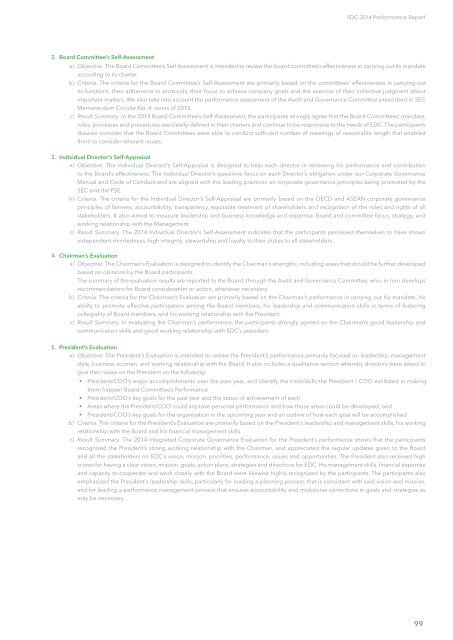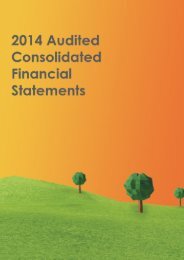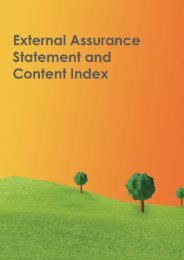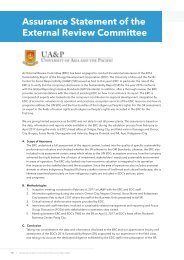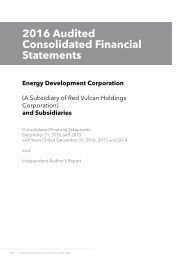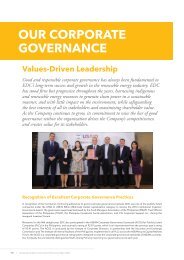EDC 2014 SR (UPDATED)
Create successful ePaper yourself
Turn your PDF publications into a flip-book with our unique Google optimized e-Paper software.
<strong>EDC</strong> <strong>2014</strong> Performance Report<br />
2.<br />
Board Committee’s Self-Assessment<br />
a) Objective. The Board Committee’s Self Assessment is intended to review the board committee’s effectiveness in carrying out its mandate<br />
according to its charter.<br />
b) Criteria. The criteria for the Board Committee’s Self-Assessment are primarily based on the committees’ effectiveness in carrying out<br />
its functions, their adherence to protocols, their focus to achieve company goals and the exercise of their collective judgment about<br />
important matters. We also take into account the performance assessment of the Audit and Governance Committee prescribed in SEC<br />
Memorandum Circular No. 4, series of 2012.<br />
c) Result Summary. In the <strong>2014</strong> Board Committee’s Self-Assessment, the participants strongly agree that the Board Committees’ mandate,<br />
roles, processes and procedures are clearly defined in their charters and continue to be responsive to the needs of <strong>EDC</strong>. The participants<br />
likewise consider that the Board Committees were able to conduct sufficient number of meetings of reasonable length that enabled<br />
them to consider relevant issues.<br />
3.<br />
4.<br />
Individual Director’s Self-Appraisal<br />
a) Objective. The Individual Director’s Self-Appraisal is designed to help each director in reviewing his performance and contribution<br />
to the Board’s effectiveness. The Individual Director’s questions focus on each Director’s obligation under our Corporate Governance<br />
Manual and Code of Conduct and are aligned with the leading practices on corporate governance principles being promoted by the<br />
SEC and the PSE.<br />
b) Criteria. The criteria for the Individual Director’s Self-Appraisal are primarily based on the OECD and ASEAN corporate governance<br />
principles of fairness, accountability, transparency, equitable treatment of shareholders and recognition of the roles and rights of all<br />
stakeholders. It also aimed to measure leadership and business knowledge and expertise, Board and committee focus, strategy, and<br />
working relationship with the Management.<br />
c) Result Summary. The <strong>2014</strong> Individual Director’s Self-Assessment indicates that the participants perceived themselves to have shown<br />
independent-mindedness, high integrity, stewardship and loyalty to their duties to all stakeholders.<br />
Chairman’s Evaluation<br />
a) Objective. The Chairman’s Evaluation is designed to identify the Chairman’s strengths, including areas that should be further developed<br />
based on opinions by the Board participants.<br />
The summary of the evaluation results are reported to the Board, through the Audit and Governance Committee, who, in turn develops<br />
recommendations for Board consideration or action, whenever necessary.<br />
b) Criteria. The criteria for the Chairman’s Evaluation are primarily based on the Chairman’s performance in carrying out his mandate, his<br />
ability to promote effective participation among the Board members, his leadership and communication skills in terms of fostering<br />
collegiality of Board members, and his working relationship with the President.<br />
c) Result Summary. In evaluating the Chairman’s performance, the participants strongly agreed on the Chairman’s good leadership and<br />
communication skills and good working relationship with <strong>EDC</strong>’s president.<br />
5.<br />
President’s Evaluation<br />
a) Objective. The President’s Evaluation is intended to review the President’s performance primarily focused on leadership, management<br />
style, business acumen, and working relationship with the Board. It also includes a qualitative section whereby directors were asked to<br />
give their views on the President on the following:<br />
• President/COO’s major accomplishments over the past year, and identify the traits/skills the President / COO exhibited in making<br />
them happen Board Committee’s Performance<br />
• President/COO’s key goals for the past year and the status of achievement of each<br />
• Areas where the President/COO could improve personal performance and how those areas could be developed; and<br />
• President/COO’s key goals for the organization in the upcoming year and an outline of how each goal will be accomplished<br />
b) Criteria. The criteria for the President’s Evaluation are primarily based on the President’s leadership and management skills, his working<br />
relationship with the Board and his financial management skills.<br />
c) Result Summary. The <strong>2014</strong> Integrated Corporate Governance Evaluation for the President’s performance shows that the participants<br />
recognized the President’s strong working relationship with the Chairman, and appreciated the regular updates given to the Board<br />
and all the stakeholders on <strong>EDC</strong>’s vision, mission, priorities, performance, issues and opportunities. The President also received high<br />
scores for having a clear vision, mission, goals, action plans, strategies and directions for <strong>EDC</strong>. His management skills, financial expertise<br />
and capacity to cooperate and work closely with the Board were likewise highly recognized by the participants. The participants also<br />
emphasized the President’s leadership skills, particularly for leading a planning process that is consistent with said vision and mission,<br />
and for leading a performance management process that ensures accountability and midcourse corrections in goals and strategies as<br />
may be necessary.<br />
99


